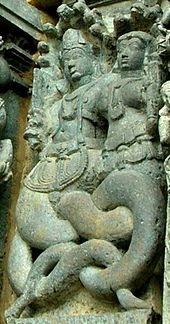பாதாளம்
பாதாளம், (Patala) (சமக்கிருதம்: पाताल, Pātāla), இந்து அண்டவியலில், பூமிக்கு அடியில் நாக தேவதைகள் வாழிடங்களாக கூறப்படுகிறது.[1][2][3]


இந்து அண்டவியலில் சுவர்க்கம், பூமி, மற்றும் பாதாளம் என மூன்றாக பிரிக்கப்படுகிறது.[4] ஏழு கீழ் உலகங்களில் இறுதியாகக் கூறப்படும் பாதள உலகம்,[5][6][7] ஏழாவதும், கீழானதும் ஆகும். பாதாளம் உலகம் நாகர்கள் வாழ்வதால் நாகலோகம் என்பர். மேலும் நாகர்களின் உறவினர்களான அசுரர்கள், தானவர்கள், தைத்தியர்கள் மற்றும் இயக்கர்களும் பாதளத்தில் வாழ்கின்றனர்.[8]
சூரிய சித்தாந்த சாத்திரங்களின் படி, பூமியின் தென் துருவத்தை பாதாளம் என்றும் வட துருவத்தை நாவலந்தீவு என்றும் குறிப்பிடுகிறது.
பாகவத புராணம், ஏழு கீழ் உலகங்களில் ஒன்றாக பாதளத்தை குறிப்பிடுகிறது. அசுரர்களின் கட்டிடக் கலைஞரான மயன், பாதாள லோகத்தில் பல அழகிய கட்டிடங்கள் கட்டினார். [7]
விஷ்ணு புராணம், ஏழு கீழ் உலகங்களை, அதலம், விதலம், நிதலம், தலாதலம், மகாதலம், சுதலம் மற்றும் பாதாளம் பெயர்களால் குறிப்பிடுகிறது.[8] பாதளத்தில் வசிக்கும் ஆயிரம் தலை கொண்ட, நாகர் இன தலைவரான ஆதிசேஷன், இப்பூமியை தாங்குவதாக கூறப்படுகிறது.[8][9] [4] பாதள உலகத்தின் கீழ், இறப்பிற்குப் பின் பாவிகள் வசிக்கும் நரக லோகம் உள்ளதாக கருதப்படுகிறது. [8]
இதனையும் காண்க
தொகுமேற்கோள்கள்
தொகு- ↑ Search for "paataala" in: "Apte Sanskrit Dictionary Search". Archived from the original on 24 ஜூலை 2010. பார்க்கப்பட்ட நாள் 1 July 2010.
{{cite web}}: Check date values in:|archive-date=(help) gives results: "1.the last of the seven regions or worlds under the earth said to be peopled by naagas; 2.the lower regions or world in general" - ↑ Wilson, Horace Hayman (1865). "Chapter V". The Vishnu Purana (Translation). Vol. II. London: Trubner & co. pp. 209–213.
- ↑ Mani, Vettam (1975). Puranic Encyclopaedia: A Comprehensive Dictionary With Special Reference to the Epic and Puranic Literature. Delhi: Motilal Banarsidass. pp. 580–1. பன்னாட்டுத் தரப்புத்தக எண் 0-8426-0822-2.
- ↑ 4.0 4.1 Parmeshwaranand 2001, ப. 762-3.
- ↑ Dimmitt, Cornelia; Buitenen, Johannes Adrianus Bernardus (1978). Classical Hindu mythology: a reader in the Sanskrit Purāṇas. Temple University Press. pp. 348–350.
- ↑ Dimmitt, Cornelia; Buitenen, Johannes Adrianus Bernardus (1978). Classical Hindu mythology: a reader in the Sanskrit Purāṇas. Temple University Press. pp. 48–49.
- ↑ 7.0 7.1 Prabhupada. "Bhagavata Purana 5.24". The Bhaktivedanta Book Trust International, Inc. Archived from the original on 4 ஜனவரி 2010. பார்க்கப்பட்ட நாள் 1 July 2010.
{{cite web}}: Check date values in:|archive-date=(help) - ↑ 8.0 8.1 8.2 8.3 Wilson 1865, ப. 209–213.
- ↑ Dimmitt 2012, ப. 348-350.
ஆதார நூற்பட்டியல்
தொகு- Dimmitt, Cornelia (2012). Classical Hindu Mythology: A Reader in the Sanskrit Puranas. Temple University Press. பன்னாட்டுத் தரப்புத்தக எண் 978-1-4399-0464-0.
{{cite book}}: Invalid|ref=harv(help) - Māṇi, Veṭṭaṃ (1998). Purāṇic Encyclopaedia: A Comprehensive Dictionary with Special Reference to the Epic and Purāṇic Literature. Motilal Banarsidass. பன்னாட்டுத் தரப்புத்தக எண் 978-81-208-0597-2.
{{cite book}}: Invalid|ref=harv(help) - Mayer, Robert (2007). "The Importance of the Underworlds: Asuras’ Caves in Buddhism, and Some Other Themes in Early Buddhist Tantras Reminiscent of the Later Padmasambhava Legends". Journal of the International Association of Tibetan Studies (JIATS) 3. http://www.thlib.org/static/reprints/jiats/03/dls/mayerJIATS_03_2007.zip.
- Parmeshwaranand (2001). Encyclopaedic Dictionary of Puranas. Sarup & Sons. பன்னாட்டுத் தரப்புத்தக எண் 978-81-7625-226-3.
{{cite book}}: Invalid|ref=harv(help) - Wilson, Horace Hayman (1865). Works...
{{cite book}}: Invalid|ref=harv(help)